This post may contain affiliate links. If you make a purchase through a link, I may receive a small commission, at no cost to you. These commissions help keep this website up and running, and I thank you for your support. Read my full disclosure here.
The famous Tintagel Castle on the beautiful Cornwall coast is steeped in the legend of King Arthur. This story originated in the 12th century, when Geoffrey of Monmouth described Tintagel as the place of Arthur’s conception in his fictionalised account of British history, the Historia Regum Britanniae (‘History of the Kings of Britain’). If you are not familiar with the story of King Arthur and his Knights of the Round Table, then I thoroughly recommend reading Bernard Cornwell’s The Winter King.
Tintagel Castle has a long and interesting history. There is evidence of Romans during the 3rd and 4th centuries, and from 450 to 650 the headland was a bustling trade centre. It was then abandoned for over 500 years until the 12th century, when Richard, Earl of Cornwall, began building himself a castle here. However, the area began to suffer from coastal erosion, which led to it being abandoned again, with only a few staff remaining to maintain the site. For many years, only sheep grazed here, but much later in Victorian times, the fascination of King Arthur’s legend led to a revival of Tintagel, and people flocked here. Since then, this beautiful site has been a very popular tourist destination. When you visit this magical place, you will see why.
We visited Tintagel on a lovely sunny summer’s day as part of our holiday around the coast of Cornwall. As we drove into the village along the B3263, there was cheap parking in a field on the left. It operates with a charity box (so bring coins) that has seen better days. It’s about a 10 minute flat walk to the ticket office. There is also parking in the town, but it is more expensive and can get busy during the summer months.
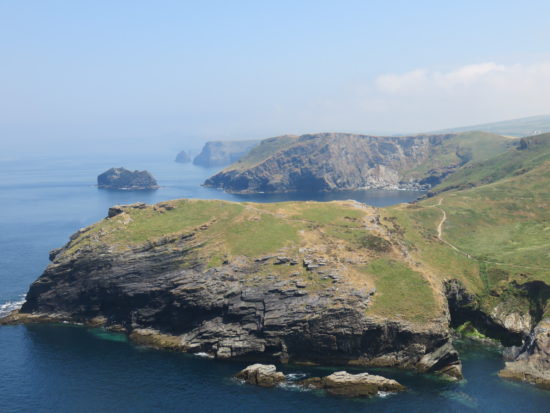
You may be surprised to know that Charles, the Prince of Wales, actually owns this piece of land, but it is managed by English Heritage. Therefore, if you are an English Heritage member, you will get in for free, otherwise, there is an entry fee. The entrance to Tintagel is on Castle Road, which is off Fore Street – the main street which runs through the village. You will see a ticket office as you turn off the main street.
The walk down to Tintagel is rather steep. Not so bad on the way down, but good exercise on the way back! If you have limited mobility, for a small fee you can jump in one of their 4WD’s which run people back and forth between the visitor centre and ticket office. Unfortunately, the geography of this site make visits beyond the visitor centre impractical, if not impossible, for visitors with limited mobility.
As we arrived at the main visitor centre, we popped in to see the small exhibit that outlines the history of the castle. There is also a gift shop here where they were offering free tastings of locally made mead. I’ve never tried mead before but was not expecting it to be sooo sweet! There are also some toilets here and a cafe here as well.
As we headed down to the beach, the coastline opened up before us, and we were absolutely mesmerised by the beauty of this place. I’m not a particularly spiritual person, but there really was a magical feeling about this place. Wondering around this historic site felt surreal at times.
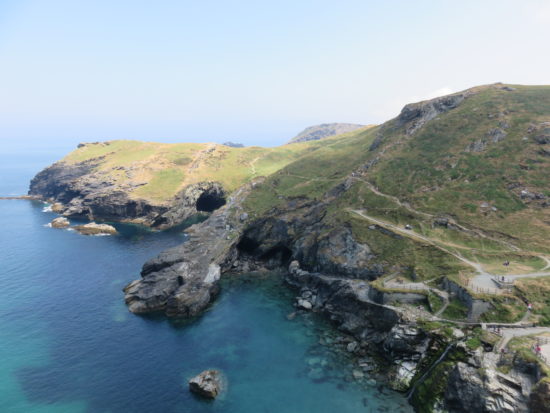
Despite it being busy, it didn’t feel too crowded. This place is huge, so visitors are spread out over a large area. Down by the water, the tide was on its way out, slowly exposing the beach and Merlin’s Cave. We walked up to the bridge that takes you across to the headland and castle (you need to show your ticket here to cross). Tintagel Island is actually a peninsula attached to the mainland by a narrow neck of land, and the bridge makes it accessible. The walk across the bridge provides stunning views of the area. To get to the Island courtyard and Great Hall, you need to walk up quite a long set of stone stairs, but it is worth it! At the top are the ruins of the Great Hall.
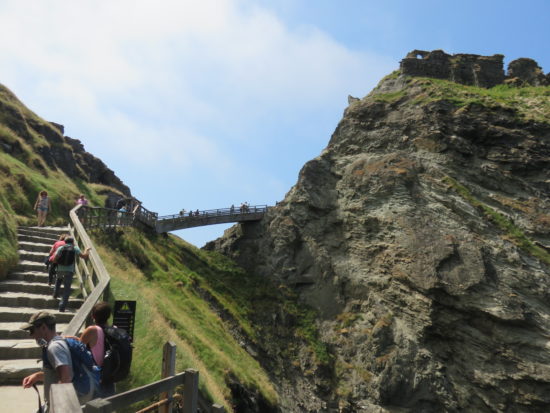
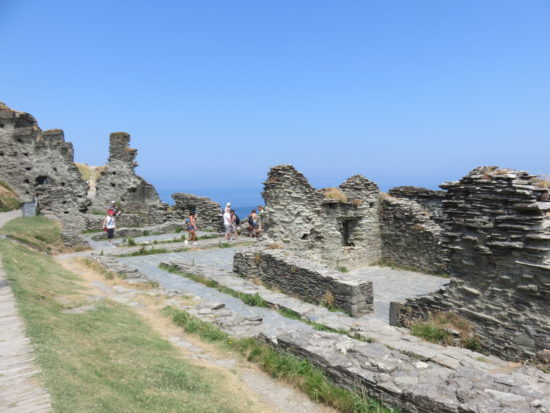
We continued to walk up the hill and past the remains of small dwellings that date back to the Dark Ages, when this was a bustling trade area. I tried to imagine what it must have been like living here all those years ago in such basic conditions. This area offers stunning views of the Tintagel coastline. I recommend bringing a picnic lunch to enjoy here. It was a beautiful summer day, and the breeze coming off the ocean was lovely and cooling. This is a peaceful spot to just sit and contemplate life.
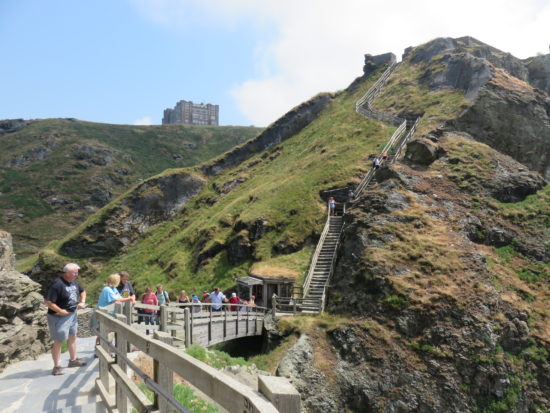
We came across a place called the garden, which most visitors didn’t seem to notice, but I fell in love with. It was once a medieval garden, but these days you won’t find any flowers here. Instead, this stone walled area features stone stepping stones all the way around the inside perimeter. The stepping stones tell the romantic story of Tristan and Iseult. I thoroughly recommend you take the time to follow the stones’ story.
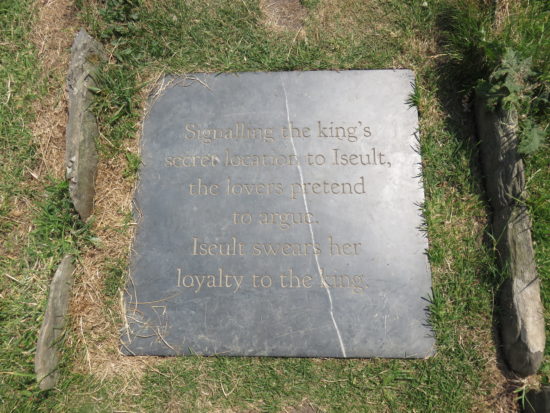
Across from the garden, we found the remains of the chapel where we read the rather sad story of the Chaplain who was forced to stay here following its abandonment. There was no one else here except for a few locals who remained to maintain the castle. Further along, there is a well and also a tunnel, which you can walk through to the very cool sculpture of King Arthur. Behind him are more stunning coastal views.
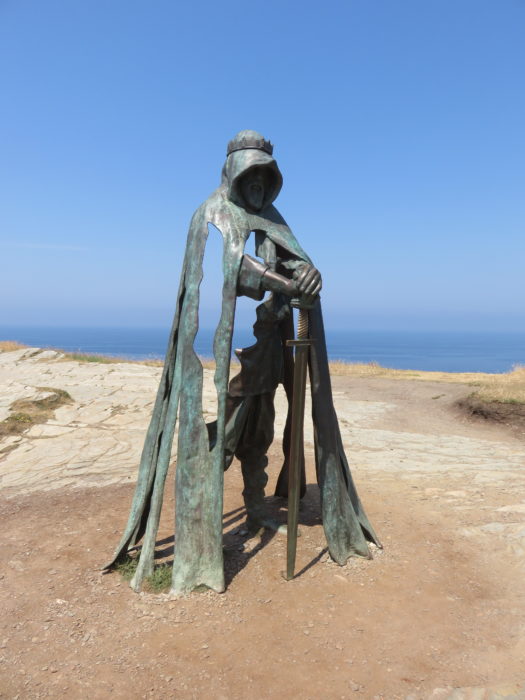

After exploring Tintagel Island, we headed back down the stone stairs and across the bridge to ascend the very, very steep steps, which took us to the Gatehouse Courtyard and upper mainland courtyard. This area actually connects with the famous South West Coast Path, so if you are hiking along this path, you can enter the castle from this side.
Once we finally made our way back down to the main visitor area, the tide had retreated enough to expose the beach and provide us access to Merlin’s cave without getting our feet wet. The Legend tells of this cave being home to the famous wizard Merlin. It is 100m long and runs all the way through Tintagel Island from Tintagel Haven on the east to West Cove on the west.
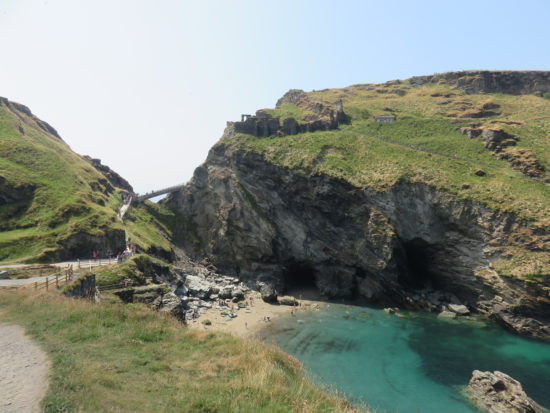
Before leaving Tintagel, we went for a walk along the other side of the coastline, along the South West Coast Path, where we enjoyed stunning views over Tintagel Castle. Before we tackled the steep hill back to the village, we stopped for a cooling, creamy local Cornish ice cream at the visitor centre to gather our strength.

Nearby Attractions
King Arthur’s Great Hall
Fore St, Tintagel PL34 0DA
Built by millionaires with a dream in the 1930s, this place recreates vast halls that tell the story of King Arthur and his brave Knights. It is features stunning stained windows and a very large hall, complete with a large stone circular table. This place is fun and stimulates the imagination, so it’s a good idea to visit this place before heading down to Tintagel Castle ruins.

The Old Post Office
Fore Street, Tintagel, Cornwall, PL34 0DB
On the main street sits a wonderful 14th-century yeoman’s farmhouse with a wavy slate roof. It was always lived in as a home, but during the Victorian period, it was also used as the local post office. FYI, it’s been a very long time since it operated as an actual post office, although whilst we were visiting, some people did turn up and attempt to post some letters! This property is owned and managed by the National Trust, so it is free for members, but there is a small fee for non-members. The home has been furnished with furniture dating back to the 16th century and also has some Victorian postal equipment on display. There is a beautiful cottage garden out the back where they had a trunk of Victorian outfits to dress up in, so we couldn’t resist!
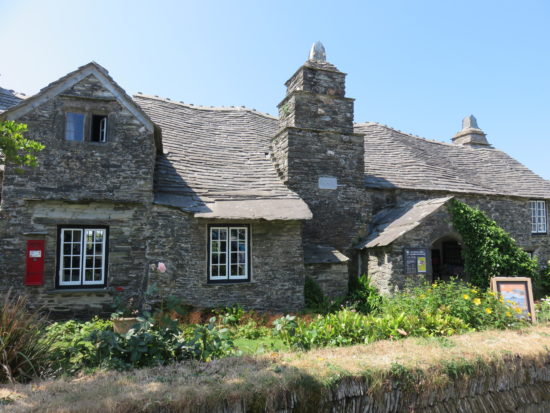
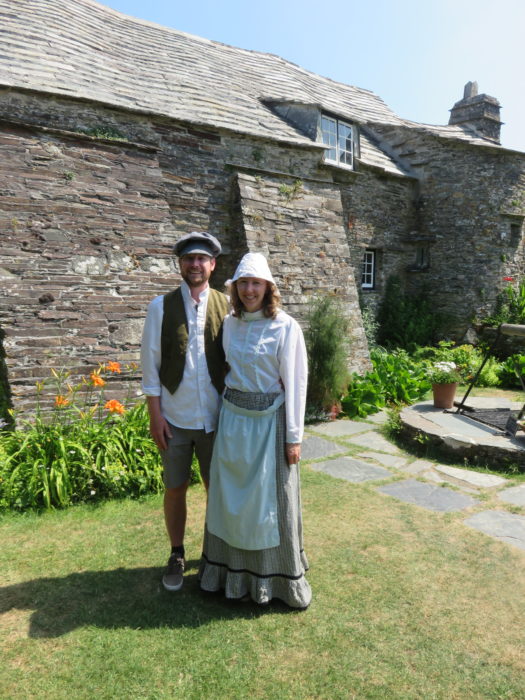
Practical Tips for Visiting Tintagel
- Parking: As you drive into the village along the B3263, there is cheap parking in the field on the left. It operates an honesty box that has seen better days, so bring coins. It’s about a 10 minute flat walk to the ticket office. However, there is also parking in town of the main street, but it is more expensive and can get busy during the summer months.
- Tickets: Tintagel Castle is managed by English Heritage. Therefore, if you are an English Heritage member, you will get in for free, otherwise, there is an entry fee.
- On a tight budget: If you are on a very tight budget and can’t afford the entry fee, you can still see Tintagel Castle – from a distance. To cross the bridge, you need a ticket, but you can still explore the visitor area, the beach, Merlin’s cave and the cliffside across from Tintagel Island, where you will get great views of the island and the castle ruins. You can also swim on the small beach. Ticketed access is only required to cross the bridge to Tintagel Island.
- Accessibility: The walk down to Tintagel is rather steep, not so bad on the way down, but good exercise on the way back! However, for a small fee you can jump in one of their 4WD, which they use to run people up and down. Unfortunately, the geography of this site makes visits beyond the visitor centre impractical, if not impossible, for visitors with accessibility needs.
- Tours: If you can’t get to Tintagel by car, then don’t worry, you can still visit by joining a tour. Check out all available tours to Tintagel Castle.
- Bring a picnic: On a sunny day, Tintagel is a wonderful place for a picnic. If you haven’t brought one with you, then just grab some sandwiches at one of the sandwich shops on your way through Tintagel town.
- Wear comfy walking shoes and bring water: There are paths, but the terrain can be uneven, and there is so much to see and do here, so you will be walking for most of your visit so wear comfy walking shoes. During the summer, it can get very hot, and with all the steep steps and cliffside it is very thirsty work. They do sell Cornish ice creams at the onsite cafe!
- Language: English
- Currency: British pound
- Tipping: Not required, but people usually round up.
- Electricity: The electrical current is 230 volts AC. Wall outlets take a three pronged plug only used in the United Kingdom and Ireland. However, you are better off purchasing a worldwide adaptor that can be used in the United Kingdom as well other countries. At least then you can potentially get some further use out of it on future vacations. If you’re taking several electronics with you, then I would recommend purchasing a couple of these adaptors.
- Driving: In the UK they drive on the left hand side of the road with speed signs in miles per hour (mph).
- Fuel: Fuel is expensive in the UK, so save money by downloading a UK fuel app so you can search for the nearest petrol station with the cheapest fuel.
- Navigating: We used Google’s free Offline Maps. Google Offline Maps allows you to access free maps for navigating that can be used offline i.e. you don’t need WIFI, data, or roaming to be able to use them. Follow my detailed guide on how to use Google’s Offline Maps.
- Using your phone as a GPS will drain your battery quickly, so use a portable battery charger, which you can use to charge your phone and any other USB chargeable devices.
- If you prefer a paper map, then purchase a road map before you go. At least it’s reliable and won’t run out of battery or malfunction like the electronic options!

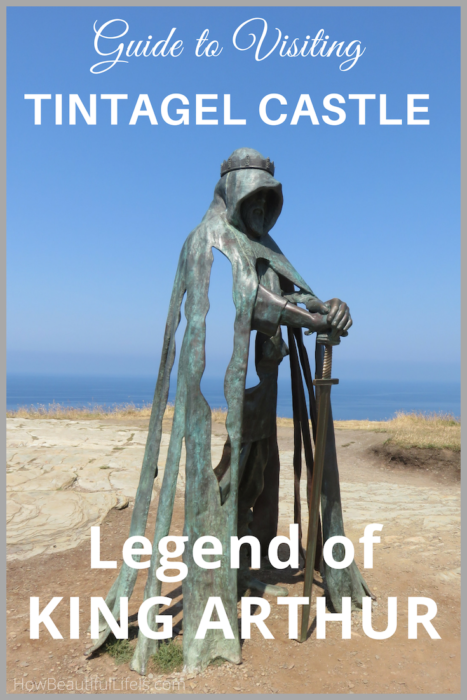
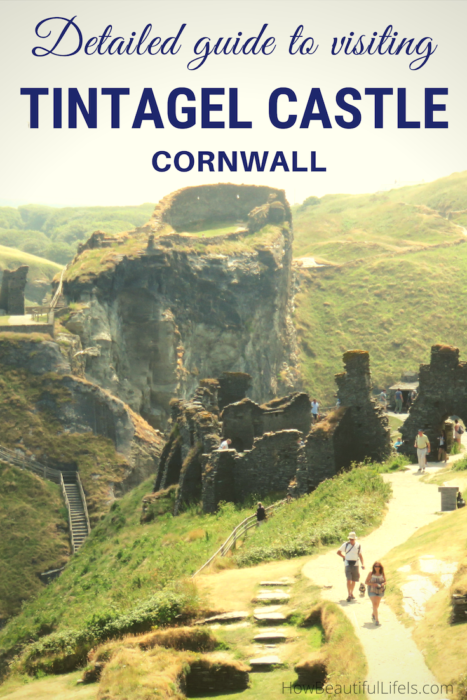
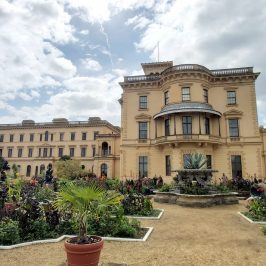
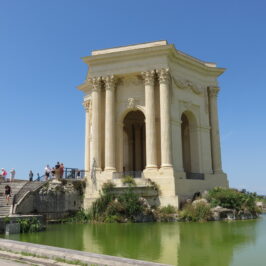
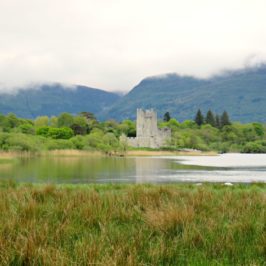
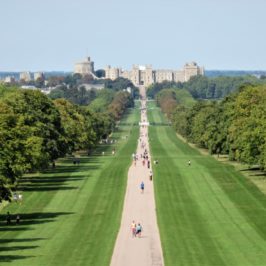


Leave a Reply